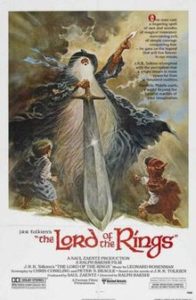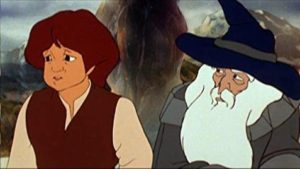The Lord of the Rings **** (1978, voices Christopher Guard, William Squire, Michael Scholes, John Hurt, Simon Chandler, Dominic Guard) – Classic Movie Review 9946

Ralph Bakshi, the maker of the provocative 1972 animation Fritz the Cat, was an intriguing choice to animate J R Tolkien’s The Lord of the Rings saga (partly using actors as a basis for the drawings) about the clash between good and evil in the kingdom of Middle Earth as a group of hobbits, elves, men, dwarves, and wizards form a fellowship and embark on a quest to destroy the One Ring made by the dark lord Sauron.
Alas, this striking, bold and ambitious 1978 animated film version is rather indigestible as a whole and muddled in places, but with colourful, often exciting images, and imaginative and appealing sequences, and overall adventurous, pioneering and valuable. An impressive technical and imaginative achievement, it is easy to enjoy and admire.
However, long though it is at 132 minutes, it comprises only The Fellowship of the Ring (1954) and the first half of The Two Towers (1954) and then stops half way through the story, as though there is supposed to be a sequel. It was indeed intended to be The Lord of the Rings Part One, but United Artists decided to release the film without indicating a sequel would follow thinking audiences would not pay to see half a film, upsetting Bakshi.
Back in late 1969, John Boorman was commissioned by United Artists to write a script, but then in 1970 UA decided that it would be too expensive to make. Then In 1975, Bakshi convinced United Artists executive Mike Medavoy to produce The Lord of the Rings as two or three animated films. But only this Part One ever materialised.
It is an adult-oriented animation, unsuitable for younger children.
Technically, it is noted as a hybrid of traditional cel animation and rotoscoping, ie shooting scenes in live action then tracing them onto animation cels. Most of the film’s crowd and battle scenes use a different technique, in which live-action footage is solarised to produce a more 3D look.
Bakshi summed up: ‘The film is a clash of a lot of styles. I like moody backgrounds. I like drama. I like a lot of saturated colour. I think we’ve achieved real illustration as opposed to cartoons.’
It was one of the first animated films to be presented in cinemas in Dolby stereo.
The screenplay is by fantasy author Peter S Beagle, based on an earlier draft by Chris Conkling, both of them credited.
The voice cast is: Frodo – Christopher Guard, Gandalf – William Squire, Sam – Michael Scholes, Aragorn – John Hurt, Merry – Simon Chandler, Pippin – Dominic Guard, Bilbo –Norman Bird, Boromir – Michael Graham Cox, Legolas – Anthony Daniels, Gimli – David Buck, Gollum – Peter Woodthorpe, Saruman – Fraser Kerr, Théoden – Philip Stone, Wormtongue – Michael Deacon, Elrond – André Morell, Innkeeper – Alan Tilvern, Galadriel – Annette Crosbie, Treebeard – John Westbrook.
It is produced by the courageous, adventurous and ambitious Saul Zaentz. Bakshi encountered The Lord of the Rings in the mid-1950s while working as an animator for Terrytoons and had made several attempts to film it as an animation before the funding by Zaentz and distributor United Artists. However, Zaentz and Bakshi reportedly enjoyed a tricky working relationship, not always seeing eye to eye, which made a Part Two less likely.
It is remade as a three-movie live-action adventure in 2001 – 2003, Peter Jackson’s The Lord of the Rings film trilogy. Jackson said that Bakshi’s film introduced him to The Lord of the Rings and ‘inspired me to read the book’. He said he enjoyed the film and wanted to know more.
The Lord of the Rings was a financial success, costing $4 million, and grossing $30.5 million in North America and more than $3.2 million in the UK. However, fan reaction was scathing about Bakshi’s liberties with the story and the characters, and UA felt that the film ‘failed to overwhelm audiences’. Nevertheless Part Two was still on the cards. But Bakshi allegedly argued with Zaentz and refused to do Part Two either over the dropping of the ‘Part One’ subtitle or over Bakshi’s fee to make the sequel.
© Derek Winnert 2020 Classic Movie Review 9946
Check out more reviews on http://derekwinnert.com


